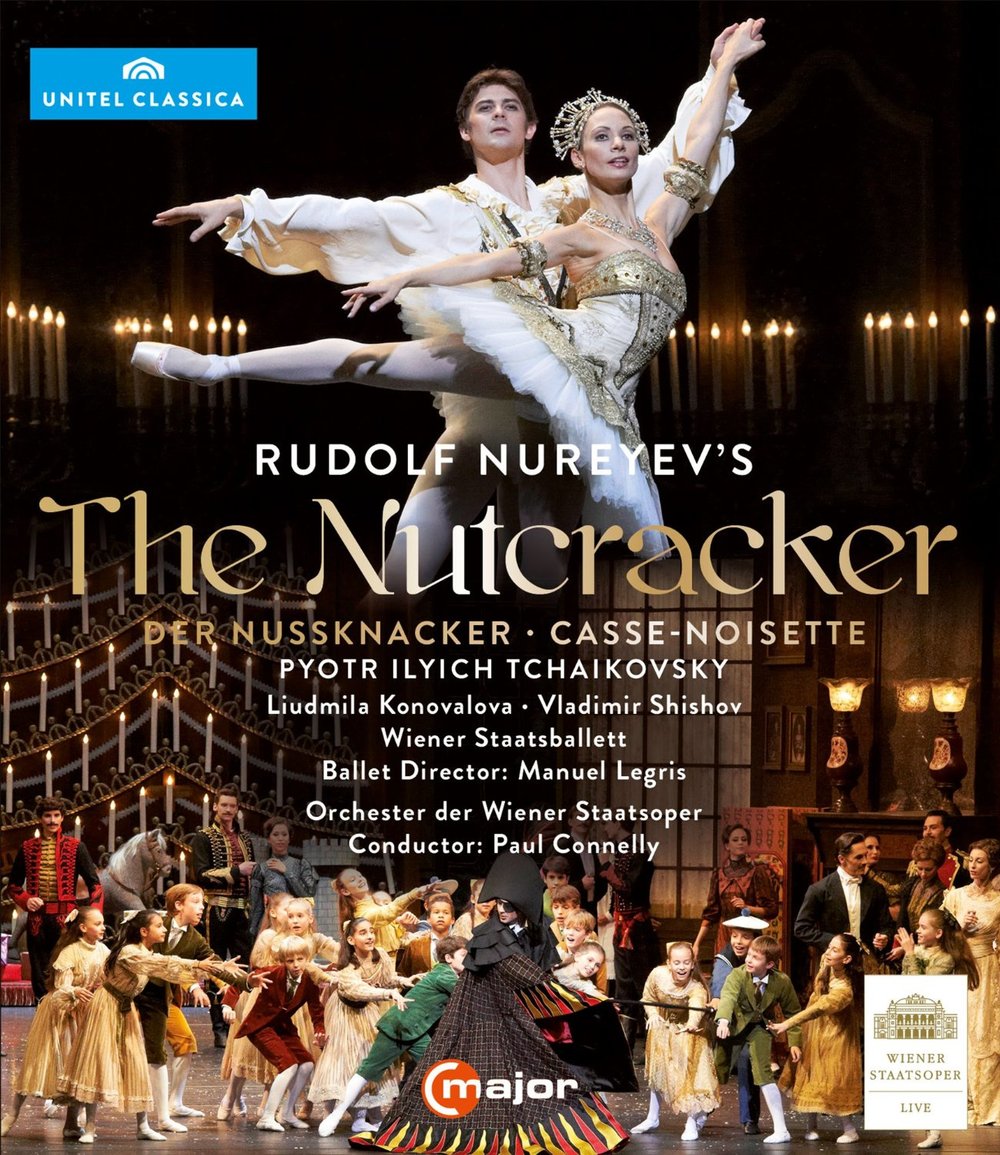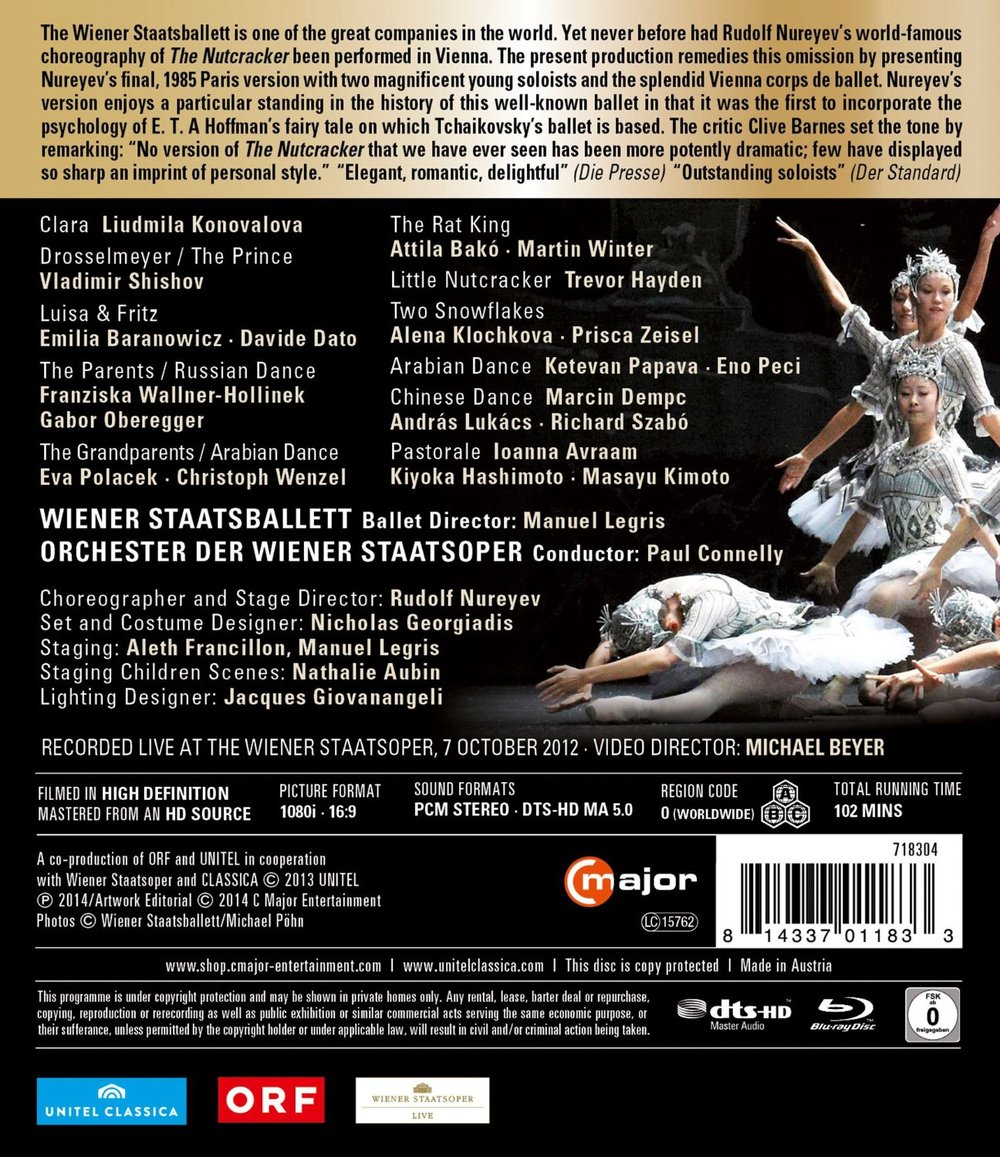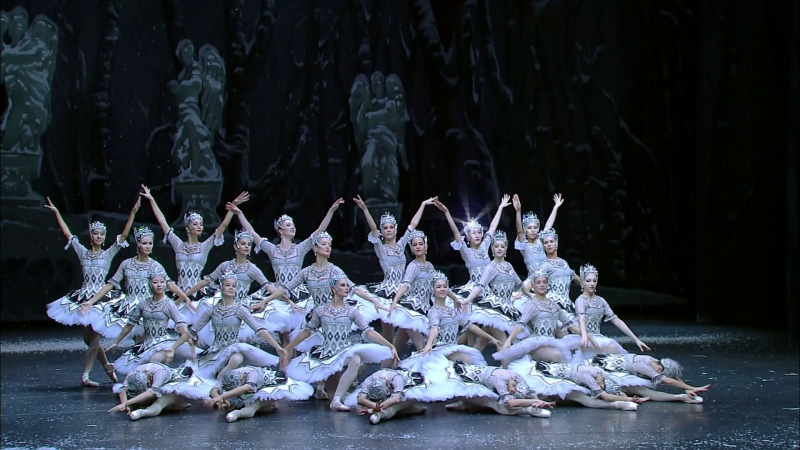

The Nutcracker ballet. Music by Tchaikovsky to libretto by Marius Petipa. Choreographed and staged per Rudolf Nureyev under direction of Manuel Legris. Performed 2012 at the Wiener Staatsoper. Stars Liudmila Konovalova (Clara), Vladimir Shishov (Drosselmeyer/The Prince), Emilia Baranowicz (Luisa/Spanish Dance), Davide Dato (Fritz/Spanish Dance), Franziska Wallner-Hollinek and Gabor Oberegger (The Parents/Russian Dance), Eva Polacek and Christoph Wenzel (The Grandparents/Arabian Dance), Atilla Bakó and Martin Winter (The Rat King), Trevor Hayden (Little Nutcracker), Alena Klochkova and Prisca Zeisel (Two Snowflakes), Ketevan Papava and Eno Peci (Arabian Dance), Marcin Dempc, András Lukács, and Richard Szasbó (Chinese Dance), Ioanna Avraam, Kiyoka Hashimoto, and Masayu Kimoto (Pastorale), plus dancers of the Corps of the Wiener Staatsballett and students of the Ballet Academy of the Wiener Staatsoper. Paul Connelly conducts the Orchestra and Stage Orchestra of the Wiener Staatsoper together with Children of the Opera School of the Wiener Staatsoper. Set and costume design by Nicholas Georgiadis; staging by Aleth Francillon and Manuel Legris; staging for children scenes by Nathalie Aubin; lighting design by Jacques Giovanangeli. Directed for TV by Michael Beyer. Released 2014, disc has 5.1 dts-HD Master Audio sound. Grade: A+
According to the keepcase booklet, the Nureyev version of The Nutcracker is performed more than any other. But this is the first production of the Nureyev version published in HDVD. Nureyev doesn't include many of the features you encounter in Nutcracker shows aimed at small children: there's no 11-year-old girl dancing Clara, no magic stage transformation, no sleigh ride, no snow storm, no candy town, and no silly humor. This show is aimed at older children and adults. It's great that the audience already knows the story from seeing lighter versions of the ballet. Nureyev challenges his audience a bit with touches of social and psychological depth in support of his real objective: to use the fairy story as a framework for a series of etudes on the art of ballet.
Nureyev starts off like everybody else with a street scene in front of Clara's house. But only Nureyev puts a wretched old woman next to the door trying to peddle roasted snacks plus a pathetic Leiermann grinding his organ in the bitter cold. Not everybody is invited to the party:
Inside, all is warm and jovial:
Clara (Liudmila Konovalova) is the woman below at the far right dressed in mint green standing near a seated man with an eye patch. The man is Clara's godfather Drosselmeyer (Vladimir Shishov), a magician whom all of the children are dying to see perform:
Drosselmeyer puts on a naturalistic show with human dolls and various illusions:
After the magic show, the older guests dance, including Clara's Grandfather (Christoph Wenzel). Many of the guests will reappear later as other characters in Clara's dreams:
Clara is too old for a ragdoll. Drosselmeyer gives her a nutcracker in the form of a wooden soldier. Clara is too young for boys, so she instantly falls in love with her nutcracker. She dozes off right in the middle of all the guests and starts to dream:
Rats attack. They remove Clara's dress, leaving her exposed in her slip! Fortunately, it's a nice new one that her mother just had made for her. Clara's escape route is cut off by the towering Mouse King (Atilla Bakó and Martin Winter [that’s right — one dancer is sitting on the shoulders of the other — don't know who is on the bottom]):
The Nutcracker, dressed in white, leads a cavalry charge. He dismounts to infiltrate the rat ranks and kill the King:
The Nutcracker is the alter ego of Drosselmeyer. The Nutcracker turns into a handsome Prince (also danced by Vladimir Shishov). A completely strange Prince would, of course, frighten Clara (still dressed in her slip). But this Prince seems trustworthy. The Prince shows Clara how to dance like a Princess. We mentioned earlier that this production is a series of etudes. So far, we have seen children dance and a few ballroom dances by the adults. Now we get an study on basic ballet for two. All the steps are very simple and tend to be repeated with small variations. Konovalova and Shishov perform the steps exactly the same with absolute precision while giving us a grand acting display of two people falling in love. It all looks so natural and easy; but you can be sure it's not. It reminds one of one of those simple-sounding Mozart piano sonatas that are performed slowly and which make even the slightest mistake so glaringly obvious:
After Clara learns the basic steps of dancing as a Princess, the female corps performs in her honor an etude on the dancing of a white act. Most choreographers do this in pure white tutus; in keeping with the overall richness of the designs, Georgiadis provides superbly beautiful white and gray dresses:
Michael Beyer gives us a good feel for the warmth of this live performance. The enthusiastic audience applauds often. At the end of Act 1 the two stars and women's corps get a curtain call:
In Act 2, Clara has another nightmare. This time the Prince teaches Clara that bad dreams are often just distorted views of people and things she really knows to be harmless:
Clara doesn't have to go anywhere. The journey comes to her in more etudes. First the Spanish Dance:
The Arabian Dance. The Sultan looks very much like Clara's grandfather. We don't know what's happening in this scene, but we guess the Sultan has a wife, 3 concubines, a son, and a daughter-in-law. The Sultan gets a good meal, and his son gets the Sultan's purse:
Eno Peci and Ketevan Papava:
The Chinese Dance is performed by Marcin Dempc, András Lukács, and Richard Szasbó. No dragon or other props get in the way:
The Pastoral by Ioanna Avraam, Kiyoka Hashimoto, and Masayu Kimoto. No lambs or lions; just dancing in 18th century garb:
The Waltz of the Flowers with more 18th century atmosphere:
The last etude gives us all the elements of a classic pas de deux. Nureyev stays away from huge lifts to focus on simpler steps:
The final pose:
The party is over, and Clara's parents wake her up to say good bye to the guests. But Clara just walks around in a daze:
It's colder than ever outside, and the Leiermann is still begging:
Clara steps outside to wake up, and she sees Drosselmeyer giving alms to the Leierman. She holds her Nutcracker tight and ponders her future:
These screenshots should give you some idea whether you would like the Nureyev Nutcracker. It's obvious that this show has great dancing, acting, directing, sets, and incredibly beautiful costumes as well as artistic and philosophical depth. Anytime the Wiener Philharmoniker play, the music will be great. The recording of the music is marvelous with great clarity for all the instruments and their sections. In particular, we never before heard trombones and the tuba so vividly in a ballet recording. The harps were also especially exciting, something that often missing in recordings. Videographer Michael Beyer and his team do a fabulous job. This video is special and probably maxes out what is possible with 1080 TV and 48kHz/16-bit sound recording. To improve on this we must step up to 4K video with HDR and 96kHz/24-bit sound sampling. We are elated to give this an "A+" grade, and it’s our Nutcracker 1st choice, at least if no young children will be in the audience.
Here’s an official trailer:
OR



































